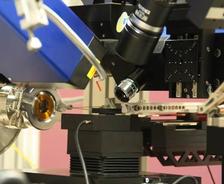An innovative drug is placed under the microscope: sample holder at the PETRA III beamline P03 (Credit: DESY).
A team of scientists of the Royal Institute of Technology (KTH) in Stockholm and DESY is using PETRA III radiation source to search for innovative ways of administering drugs to patients in very precise doses. The aim is to allow patients to be given exactly the right concentration of an active ingredient which, in addition to its therapeutic effect, may also have serious side effects. Many of the current candidates for potential coronavirus drugs have severe side effects, for example. In the medium term, such methods of drug administration could also represent a step towards personalised medicine.
During the acute coronavirus pandemic, the search for a drug against the SARS-CoV-2 virus is focusing on numerous drugs that have already been approved or are currently undergoing testing. The World Health Organization (WHO) has compiled a list of 30 to 40 such drugs and launched its programme “Solidarity”, calling on a worldwide network of scientists to study their efficacy. One problem is that some of these drugs are very aggressive and can cause severe side effects: pharmaceutical sledgehammers, such as drugs against Ebola or pancreatic cancer, can even pose a considerable risk to the life of patients if they are taken at too high a dose. This makes it all the more important for the treatment to be administered in very finely tuned doses.
The German-Swedish team wants to tackle the root of this problem and has been investigating a new approach to manufacturing and administering drugs in very low doses at the DESY's PETRA III beamline P03. DESY’s Simone Techert, who coordinates the research project together with Stephan Roth, the head of the P03 beamline, quotes Paracelsus, who said: “All things are poison and nothing is without poison; it is only the dose that makes something not a poison.” She goes on to observe that, “This is especially true of certain candidate drugs against SARS-CoV-2, also bearing in mind that the drug may be administered to patients who are already weakened by Covid-19.”
Although safety precautions were at their peak and DESY’s staff was working from home when the project was supposed to be launched, it did not take long to assemble the team to conduct the experiments. “I sent out an email asking who would like to take part in the measurements, and almost all the replies arrived within five minutes – all of them affirmative,” says Stephan Roth.
The researchers are pursuing a number of different objectives with their project. On the one hand, they want to use the ultra-fine X-ray beam to find out how a finely controlled dose of an active ingredient can be uniformly applied to a carrier – a basic prerequisite for determining the exact dose administered. The team is using different media as carriers. “Depending on whether an active substance combines better with sugar-like materials or with the amino acids of proteins, we adapt the carrier material,” says Techert. When the active ingredient is applied, it lodges in small local cavities in the carrier – a process about which the researchers hope to gain a detailed understanding with the help of X-rays. Drugs that are produced by this method could be dosed more accurately than conventional drugs and could be administered with very high precision. “Our aim is to produce smart carriers that allow controlled dosages, ranging from a few molecules up to the milligram range,” Techert explains.
At the same time, the team is using this method to investigate the basic principles of how the active ingredients behave when they come into contact with a surface – something that also occurs when they are administered in the throat, for example. “If an active ingredient crystallises because the concentration is too high, for example, this could not only reduce its efficacy, it could even be detrimental to the patient’s health,” explains Roth. A key advantage of the technical equipment available at the PETRA III beamline is that this type of experiment can also be carried out there at body temperature and thus under lifelike conditions.
The scientists, who bring together expertise from the fields of materials science, fundamental pharmaceutical research and medicine, are also continuously informing potential users of their research about the progress they are making. Simone Techert: “We are constantly in touch with university hospitals, for example, which immediately incorporate our findings into their own medical studies.” Ultimately, though, the results are meant to benefit many sectors: the pharmaceutical industry and the medical industry, as well as medical institutions, hospitals and care-related, medical-therapeutic fields.
(from DESY News)







